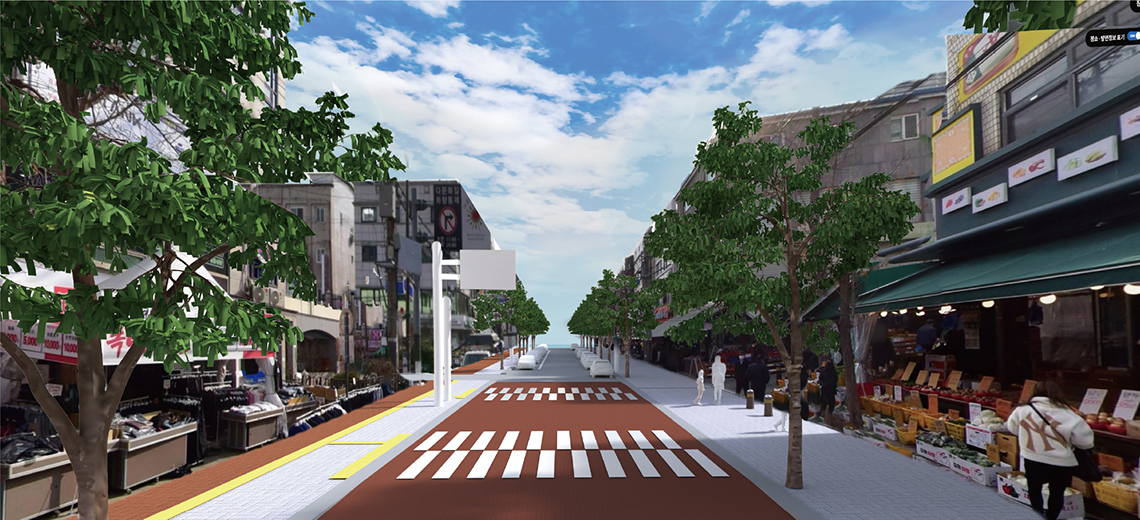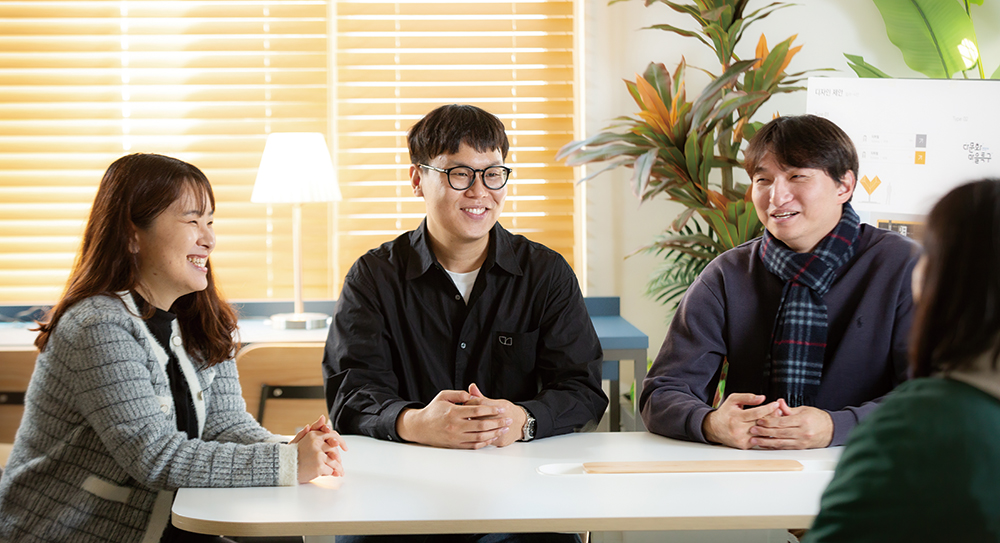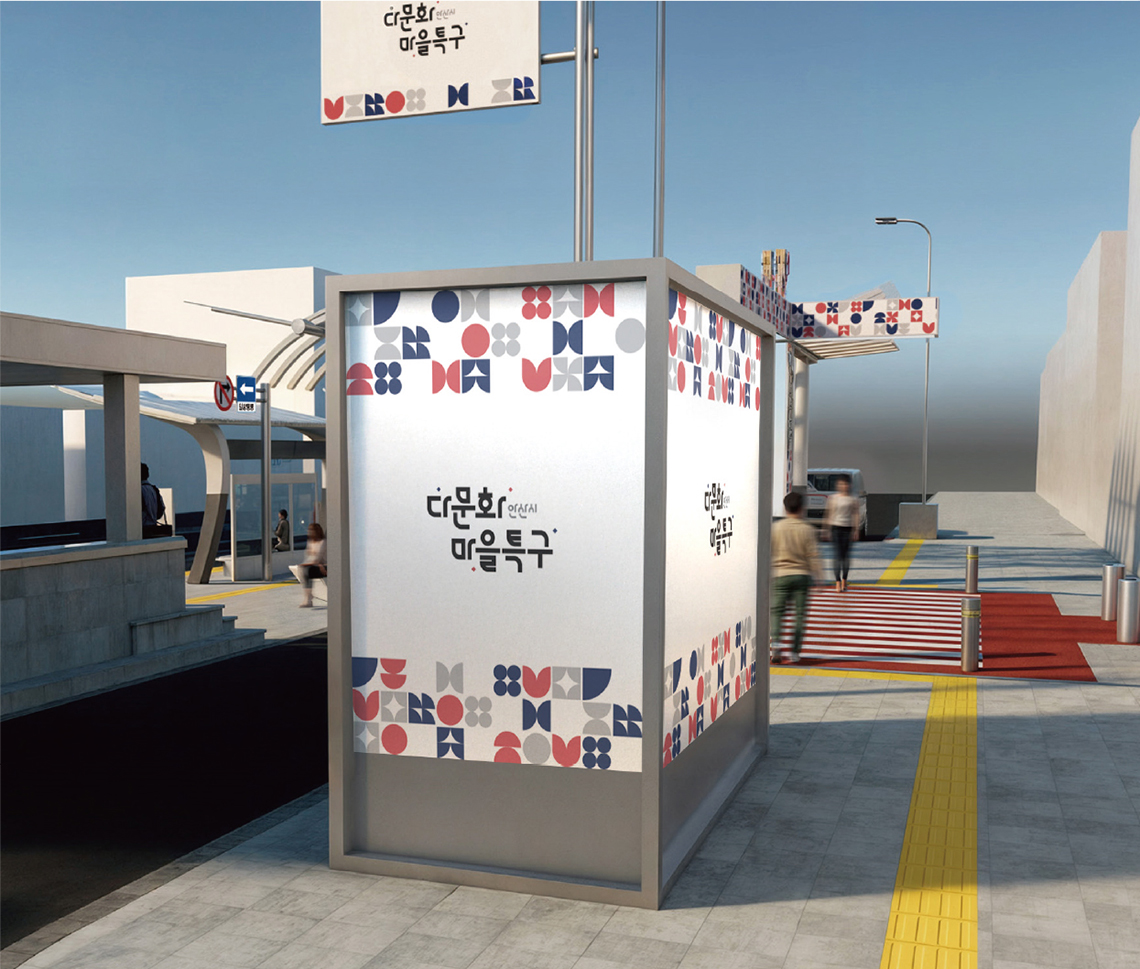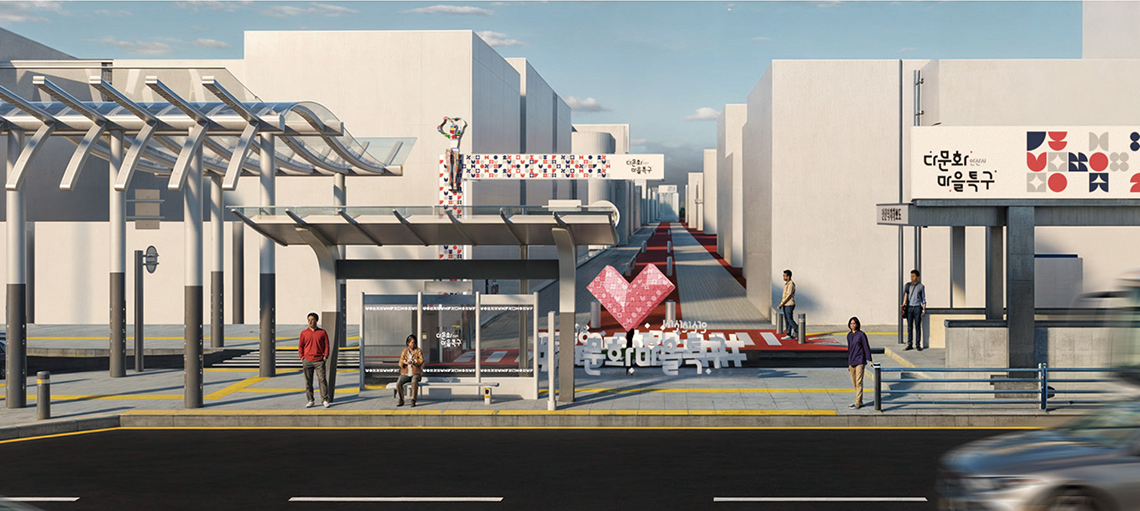Lab
Designing a City
where Diversity Exists
Public Design Lab, College of Design
- Written by · Yeon-joo Lee
- Photo by · Hong-beom Ahn
- Materials by · Public Design Lab
 Prof. Tae-seon Kim from the Department of Industrial Design, who led the project for the Ansan Multicultural Village Special Zone, and graduate students from the Public Design Lab, who were undergraduate students at the time.
Prof. Tae-seon Kim from the Department of Industrial Design, who led the project for the Ansan Multicultural Village Special Zone, and graduate students from the Public Design Lab, who were undergraduate students at the time.

Using the Collective Intelligence of 70 Individuals for 10,000 Hours to Transform the Area
The Ansan Multicultural Village Special Zone is significant in that it is a village actively welcomes immigrants of various nationalities and cultures. However, the zone still seemed far from being fully vitalized. Prof. Tae-seon Kim from the Department of Industrial Design, who led the Lab, and Prof. Euitay Jung from the Department of Communication Design, made specific design proposals in the spring of 2023 after signing a partnership agreement with the Ansan Migrant's Counseling Support Center. The agreement was created for “continuous cooperation to improve the environment and activate the community of the Ansan Multicultural Village Special Zone.” The shared concern among all participating students was that the values of diversity and coexistence inherent in the village were not being effectively conveyed. Jong-ha Kim (Department of Industrial Design, graduate student, Class of 2024), explained in the research process that, “local Koreans and original Ansan residents had a negative image of the district, associating it with ‘high crime rates’ and ‘unclean streets.’ However, this perception was often more exaggerated than the actual situation.”
“What worsened the situation was the lack of branding for the Multicultural Village Special Zone. There was no essential regional branding to attract locals to the area, and there was little service design to help visitors enjoy the rich cultural content of the area. While the district undoubtedly reflected the values of ‘diversity’ and ‘coexistence,’ there were very few ways for visitors to directly experience or feel these values.”
Jin-wook Hong (Department of Industrial Design, graduate student, Class of 2023), also pointed out that the location of the district caused a sense of disconnection.
“The large ten-lane road physically blocks the connection to surrounding areas, creating a strong sense of isolation between the two spaces. Not only is it inconvenient to access the district from the station, but the district also has a sense of being cut off, which negatively affects local revitalization.”
To improve the environment of the Multicultural Village Special Zone, three courses including the undergraduate course UX Design, and the graduate courses Social Design Workshop and Community Design, are part of IC-PBL. The international students who enrolled in the Departments of Industrial Design and Communication offer diverse perspectives and increase the project's authenticity. In total, 70 undergraduate and graduate students led by two professors spent about 10,000 hours over 16 weeks working on design solutions for the project. Yun-seo Go (Department of Industrial Design, Graduate, Class of 2020), explained the process of seeking solutions by focusing on strengthening the district's local identity and creating public designs that resonate with both visitors and residents.
“One of the important issues we wanted to address was the lack of visual elements representing the identity of the Multicultural Village Special Zone, and the absence of unity in the design of public facilities. To address these physical, environmental, and psychological separation problems, we concluded that a branding strategy was needed to create a bright and safe image to effectively convey the area's charm.”
The response has been very positive. Based on the design solutions developed over 16 weeks, the Lab was selected for Gyeonggi Province's “The Dream Project”. Moreover, in the Local Design Project by the Ministry of the Interior and Safety, it was selected as the best project, advancing to the concrete implementation phase.
 Bird's-eye view of the Multicultural Village Special Zone
Bird's-eye view of the Multicultural Village Special Zone
Regional branding and environmental
improvement are the keys for visitors
to experience the unique cultural
values of the area



Design to Promote the Essential Values of Multiculturalism
In this project, there were varied perspectives among Ansan's native and international residents, government officials, and designers. Local residents prioritized traditional identity and safety, while the international residents hoped to convey a strong cultural identity based on their country of origin. Meanwhile, government officials focused on feasibility and ease of maintenance, while designers emphasized creativity and visual impact. With these diverse opinions, the most important aspects of the project were decided to be focused on “harmony” and “empathy”. This project was not viewed as easily accommodating of the different views regarding a design solution, so the most challenging task for the participants was bridging the differences. To do so, the participants discussed solutions constantly, and listened to the opinions and experiences of those who have been living in the district. The direction was set by focusing on the experiences of the district's residents who are the actual users and consumers. Prof. Tae-seon Kim, who led the Lab, said that during the master plan development stage, they were able to clarify the project's direction by considering “the cultural backgrounds of the international residents, the potential future changes in the demographics of the residents, and the expression of cultural identity.”
“Looking into the cultural symbols of countries, we discovered visual similarities such as the cultural universalities or commonalities among humans. Although we are from different countries, we all have one thing in common which is being human. Thus, the district's visual identity was represented as an abstract, simple shape that could embrace various changes.”
Based on this conclusion, the team began to refine the district's branding with pictograms in collaboration with Ansan City. They focused on enhancing visual unity, especially for the recreational areas for the residents and visitors and improving safety through “Crime Prevention through Environmental Design” (CPTED). They developed pictograms and logos to be applied to signage, merchandise, and so on to reinforce the district's identity and increase its resonance. Jin-wook Hong added to the idea to improve public awareness of the district.
“By creating photo spots, people will be able to capture the district's charm in photos and naturally share through social media. This will contribute to the district being recognized as an attractive and safe space.”
Above all, what is most important is ensuring that the meaning of diversity and coexistence is conveyed through the Multicultural Village Special Zone. By reflecting this message in the pictograms and patterns developed by the Lab in signage and street installations, the Lab hopes to provide a consistent, positive experience and improved space utilization by creating broad multipurpose areas. In addition, designated garbage disposal areas were set up and signs were installed to show clear paths for users to address the biggest problem, waste disposal and the street environment. This functional design went beyond aesthetics, leading to real changes that greatly contributed to the clear expression of the values of diversity and coexistence in the community. Going forward, it will be important to support these changes with various cultural contents and management strategies for sustainable growth. Student Jong-ha Kim expressed his hope for the district's revitalization saying, “Regional branding and environmental improvements are the tools for experiencing the unique cultural values of the area. Through continued development of content that consistently conveys diversity and coexistence, sustainable growth will be achieved.”
The project is not over yet. It is now at the implementation design stage for construction through The Dream Project of Gyeonggi Province and Local Design Project by the Ministry of the Interior and Safety, and the solutions proposed by the students will be adjusted for practical implementation. With so many diverse ideas, further collaborations will continue. It will be exciting to witness the changes to the area resulting from the students' creative ideas local participation, and active input from others involved.

 Bird's-eye view of the Multicultural Village Special Zone, which incorporate patterns created from icons developed in the Public Design Lab.
Bird's-eye view of the Multicultural Village Special Zone, which incorporate patterns created from icons developed in the Public Design Lab.






